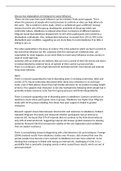Essay
AQA Psychology: all social influence 16-mark essays (graded A) and key word glossary
This document provides detailed A01 notes and A03 evaluation into all social influence essays of the social influence module, and a complete key word glossary. These notes are clear, and easy to follow. The A03 contains a deep explanation of both strengths and limitations to the theory/study, a...
[Show more]




